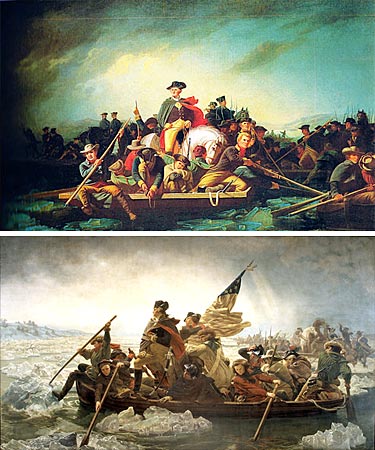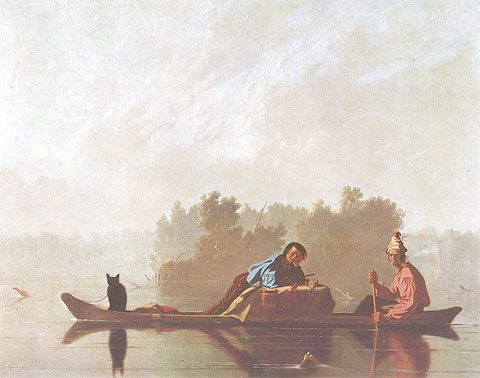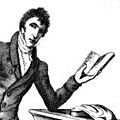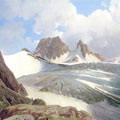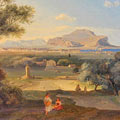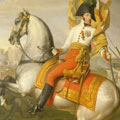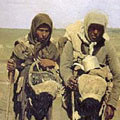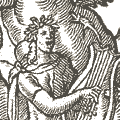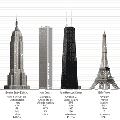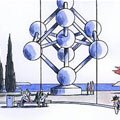de Amerikaanse schilder George Caleb Bingham (1811-1879)
Vorig jaar schreef ik hier iets over de wisselwerking tussen Amerikaanse en Duitse schilders in de negentiende eeuw. De kunstacademie van Düsseldorf speelde in het midden van de negentiende eeuw een sleutelrol. De Amerikaanse schilder Emanuel Leutze schiep hier in 1851 het icoon van de Amerikaanse schilderkunst, Washington’s oversteek over de ijzige Delaware. Een andere Amerikaanse schilder George Caleb Bingham zocht hem in 1856 in Düsseldorf op en schilderde kort daarna zijn eigen versie op dit heldhaftige moment in de Amerikaanse geschiedenis. Maar Bingham ontbrak het talent als historieschilder. Hij was veel meer een genreschilder.
Washington Crossing the Delaware
Leutze schilderde hét heroïsche moment uit de Amerikaanse geschiedenis in Düsseldorf (onder)
Bingham schilderde hetzelfde thema (boven) maar door de felle kleuren, stijfheid van de figuren en compositie is het schilderij eerder naïef dan heroïsch te noemen.
The Düsseldorf School had a significant influence on the Hudson River School in the United States, and many prominent Americans trained at the Düsseldorf Academy and show the influence of the Düsseldorf School, including George Caleb Bingham, Eastman Johnson, Worthington Whittredge, Richard Caton Woodville, William Stanley Haseltine, James McDougal Hart, and William Morris Hunt, as well as German émigré Emanuel Leutze. Albert Bierstadt applied but was not accepted. His American friend Worthington Whittredge became his teacher while attending Düsseldorf. Bron: en.wikipedia.org
Bingham‘s bekendste schilderij is het verstilde moment met twee bonthandelaren in hun bootje op de Missouri uit 1845. Het is een eenvoudig en uitgebalanceerd tafereel. Vanwege zijn gepolijste en afgewogen manier van schilderen, wordt Bingham wel eens met Nicolas Poussin vergeleken.
Fur Traders Descending the Missouri
Bingham’s bekendste schilderij uit 1845
His genre paintings -narratives of everyday life- depicted and immortalized the common man: fur traders and riverboatmen and settlers in scenes of frontier life
George Caleb Bingham (1811-1879) is renowned today as one of the classic artists of the American West. His paintings rank among the nation’s greatest art treasures. Bingham can lay claim to being the first outstanding American artist from the “West“. He is best known for his genre scenes derived from the daily life of what was then the Western frontier. Lewis and Clark and the Corps of Discovery had returned from their 1804-06 westward exploration only five years before Bingham was born. In 1820, when Bingham was nine, Missouri became the 24 th state. Bingham’s paintings from 1845-55 the decade of his best work generally relate to life and commerce along the Mississippi and Missouri rivers, and to the American scene involving the people of Missouri in and around St. Louis, Columbia, Jefferson City, Arrow Rock, Boonville, and Kansas City. His genre paintings -narratives of everyday life- depicted and immortalized the common man: fur traders and riverboatmen and settlers in scenes of frontier life (which he knew from both tradition and first hand observation); and scenes of the young nation’s democratic process: political campaigning and elections (which he knew from his deep involvement with the Whig party, with Missouri state politics and national politics, and as a seeker and achiever of political office).
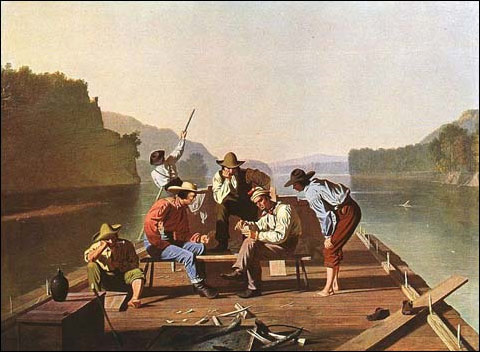
Raftsmen Playing Cards, 1847
In 1856,
Bingham with his wife and daughter Clara sailed for Europe, first to Paris, which he found alien and inhospitable and expensive and even the Louvre disconcerting. George and his family then went on to a sojourn in
Dusseldorf, where he completed full-length portraits of Washington and Jefferson (a commission from the
Missouri State Legislature, both now destroyed by fire); the second of three related flatboatmen paintings, “
Jolly Flatboatmen in Port“ (1857); “Moonlight Scene:
Castle on the Rhine“(1857, Private Collection); and probably other unrecorded works.
Düsseldorf , compared to
Paris, was a manageable city of 30,000 and a famous art center that had attracted, interestingly enough, such aspiring German-American artists as
Emanuel Gottlieb Leutze, Carl Wimar, and
Albert Bierstadt all of whom had been born in Germany and emigrated to the United States as children, only to return to Germany to study and in Leutze’s case to live in
Düsseldorf for many years where he also became a noted teacher. From the 1840s through the 1850s other American artists such as
T. Worthington Woodridge, Richard Caton Woodville, and
Eastman Johnson also studied in
Düsseldorf. Leutze, as teacher and great friend of visiting American artists, was a first stop for American expatriates, and
Bingham, although a mature and established painter, was no exception. George wrote to his friend Rollins back in
Columbia, Missouri: “Immediately upon our arrival in
Dusseldorf, I called upon Leutze, the famous painter, who received me as cordially as if I had been a brother, and without a moment’s delay assisted me in finding a Studio, and introduced me to one of his American pupils through whose guidance I shortly obtained accommodations of the best kind, and upon the most reasonable terms.“
Bron:
en.wikipedia.orggeorgecalebbingham.org
